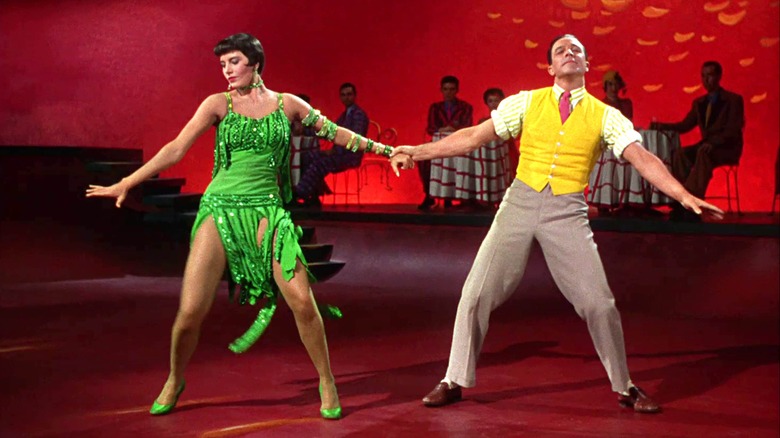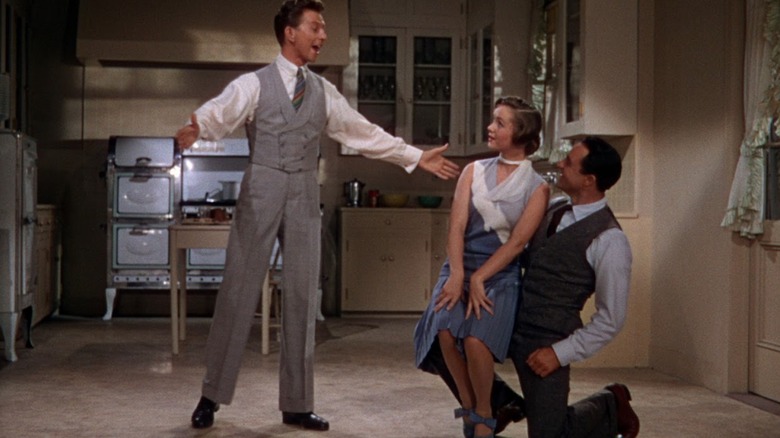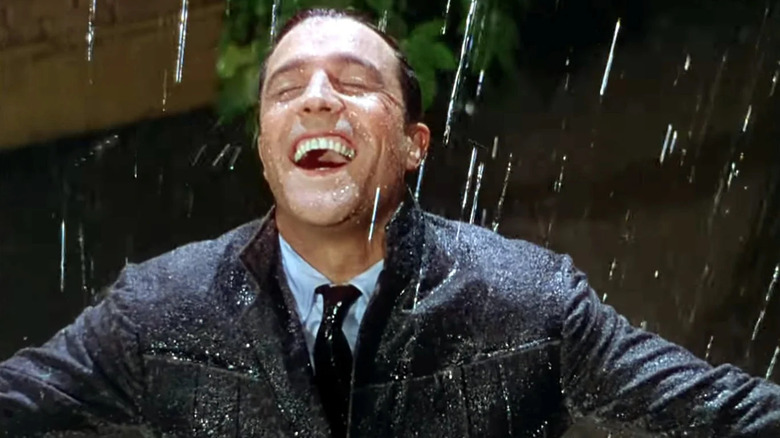Shooting In Color Caused Some Problems Behind The Scenes Of Singin' In The Rain
Stanley Donen's 1952 film "Singin' in the Rain," starring Debbie Reynolds, Donald O'Connor, and the obnoxiously chipper Gene Kelly, was once held up in the pages of /Film as the Platonic ideal of movie musicals. It is a certainly a dance showcase of the highest order, and an unapologetic Hollywood nostalgia piece. Silent films are on the way out, sound pictures are on the way in, and singing and dancing are all set to be the future of cinema. "Singin' on the Rain" is also a jukebox musical. The songs are all old standards, including the title number, which came from "The Hollywood Revue of 1929" as did "You Were Meant for Me." "You Are My Lucky Star" was from "The Hollywood Revue of 1936," and "Good Morning" came from Busby Berkeley's 1939 film "Babes in Arms." Kelly and Donen concluded their film with a very, very long — a VERY long — dream ballet sequence wherein Kelly spends a straight 13 minutes dancing to "Gotta Dance."
An additional nostalgic twist of "Singin' in the Rain" was its glorious Technicolor photography. Shot by Harold Rosson ("On the Town"), "Singin' in the Rain" was filmed in the three-strip Technicolor process. Three-strip cameras, very briefly, employed prisms to split the incoming image into three separate base colors — green, red, and blue — and exposed three separate strips of film stock simultaneously. The three strips would then be printed together, and the colors would come out that much more vibrantly.
I.B. Tech
If you, dear reader, ever see a repertory screening advertising an I.B. Tech print — short for imbibition Technicolor — you'll see that the color is as dazzling now as it was 65 years ago. Acetate color stock tended to degrade and fade faster, leaving older Kodak-developed prints looking red and washed out. Prints made in Fujicolor laboratories tended to fade to a gentle blue. When acetate begins to break down, it gives off a strong chemical odor reminiscent of vinegar, a dire degradation that many projectionists believe can spread from print to print. This is what the insider film term "vinegar syndrome" refers to.
The three-strip Technicolor process was not new in 1952. Indeed, it was only a few years from being retired altogether. The first three-strip Technicolor feature film was Rouben Mamoulian's "Becky Sharp" from 1935, photographed by Ray Rennahan of "Gone with the Wind" fame. The first short three-strip short film was the Disney animated short "Flowers and Trees," also photographed by Rennahan. Disney was an early adopter of the process.
Stanley Donen, in a 2009 interview with DGA Quarterly, recalls what it was like to film with three-strip cameras. Because there was literally triple the film stock in each camera, the machines were heavy and enormous, requiring enlarged lenses and monstrous film canisters. Donen also recalls that three-strip Technicolor required more light than any previous cameras. There was no way to make anything look "natural" in the three-strip process.
Footlambert parade
For Donen, adjusting the large, hot arclights was the biggest technical headache of making "Singin' in the Rain." Nothing, it seems, could be improvised. An experienced camera operator might be able to better elucidate as to how the lenses and mattes worked on a three-strip camera, but Donen only remembers the lighting, and how he had to blast his cast with as many footlamberts as possible. One can only imagine the temperature in a studio filled with many, many ultra-powerful lights. Donen said:
"We filmed in Technicolor. There were some physical problems because you needed an enormous amount of light in those days, compared to what we do today. The film was slow, and the lenses were not as fast, so you needed huge amounts of light. It took a long time to organize the lights because there were so many of them, and they needed constant attention. They were arc lights; they weren't incandescent. So you had to trim the arcs. Everything has got to be controlled, and everything is. It's not a documentary. It's the antithesis of a documentary."
The glorious technicolor was a throwback to color films of the '30s. Although aesthetics had changed since then, "Singin' in the Rain" still possesses a Golden Age quality that burns it into the memory. It's no wonder we called it the Platonic ideal of musicals.
The final film to use the three-strip process was Joseph von Sternberg's 1957 John Wayne vehicle "Jet Pilot." By then, 2.39:1 Cinemascope aspect ratios were more in vogue, and widescreen cameras more or less supplanted three-strip ones. Thanks to the strange alchemy and unknown caprices of film emulsion, however, the shimmering color of "Singin' in the Rain" lives on.


